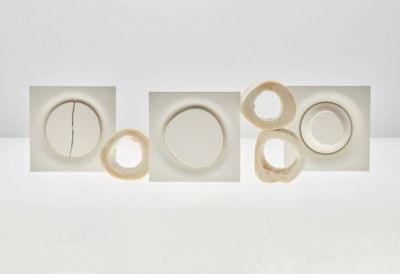Humans have found creative uses for bones since prehistoric times. Animal bones have been shaped into spoons, needles, musical instruments, and combs. Meanwhile, bone ash—created by grinding bones to fine powder—has been used in bone china since the 1700s. Now, a designer has brought one of the planet’s oldest raw materials into the 21st century by redesigning the humble electric socket—and fashioning it out of discarded bones from the meat-processing industry.
Swiss-Tunisian designer Souhaïb Ghanmi graduated from ECAL, Switzerland’s famed design school, last summer. For his diploma project, he designed Ecol, a range of electric sockets and light switches made from a bone powder composite material. As the world continues to grapple with the environmental impact of the meat industry, animal bones may seem like a controversial choice for home accessories otherwise made of plastic. But for Ghanmi, the goal is to limit waste streams that already exist: The Swiss meat industry, for example, produces more than 230,000 tons of waste each year.
Ghanmi, who now works with Danish ceramics brand Raawii, joins a host of designers using organic waste as a resource. French company Scalite designs marble-like tiles made of fish scales that otherwise would end up in landfills. California-based startup Full Cycle Bioplastics turns food waste into a kind of bioplastic that can break down in the ocean. There are lamps made from discarded orange peels and planters made of food scraps. If bones aren’t enough to make you squirm, there’s even furniture decorated with human hair collected from hairdressers. Waste is in.
There are several reasons why Ghanmi chose bone as his primary material. “It’s strong as a stone but easy to carve, like wood,” he says, equating the qualities of bone to the way we use plastic today: durable yet easy to work with. Bones are also a good electrical insulator, which explains the choice of electrical outlets.
The sockets come in organic shapes inspired by the articulation of the femur (they can even rotate). Meanwhile, the light switches were inspired by the oval shape of a bone when it’s cut.
That such a ubiquitous part of our homes—one that we use every single day without even thinking about it—could come from slaughtered animals isn’t easy to digest, but Ghanmi sees the material as one that brings value because it’s diverting it from the waste stream, not adding to it. “It’s a process until we have a better world,” he says.
To make the sockets, the bones are prepped by removing the bone marrow (or else it would decompose). Then the bones are cleaned and dried before they can be ground to fine dust. For this part, Ghanmi has tapped into an existing manufacturing chain as cattle bones are already ground to be used for animal supplements, gelatin, fertilizers, and bone china. (Lenox was the last significant manufacturer of bone china in the U.S.; the pandemic shuttered the company’s remaining factory in 2020).
Ghanmi built the first prototype with a 3D printer, but is hoping to use molds to create future versions. (He says carving the outlets from bones could have worked, but he decided against it because it would have led to more waste material.) For now, he’s testing the material to make it as durable as possible. Bone is mostly composted of calcium so it can’t decompose, but Ghanmi notes that it can be gnawed by scavengers or slowly eroded by water.
Ultimately, he wants to create a material that can be crushed back to powder and recycled into another product. And if he gets it right, he plans to use it for more home products.
Fast Company

